
Initiatives to Enhance Your Podcast's RSS Feeds

Initiatives to Enhance Your Podcast’s RSS Feeds
If you’ve started creating content for your podcast and want to increase your listener base or make your podcast easily accessible to audiences who enjoy your show, an RSS feed is the solution.
With RSS Feed, your podcast show can reach more listeners, and your audience can easily find your podcast show on any platform. So, if you’re looking to create podcast RSS feeds but don’t know how to go about it, this article will walk you through the simple steps to help you get the job done quickly and easily. So, keep reading.
- Method 1: Create an RSS feed with hosting platforms
- Method 2: Create an RSS feed without a hosting platform
- Method 3: Create your own exclusive RSS feed
Disclaimer: This post includes affiliate links
If you click on a link and make a purchase, I may receive a commission at no extra cost to you.
Part 1. What Is an Podcast RSS Feed?
RSS, Really Simple Syndication, has been around for quite a long time (since 1999), and it was introduced to allow internet users to stay connected with their favorite websites. In other words, it’s used to subscribe to news websites, emails, blogs, podcasts, etc. It is just a simple link looking like this:
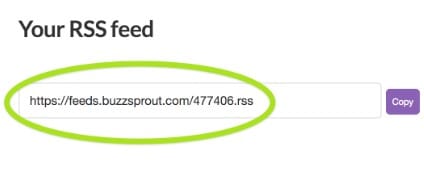
Your Podcast RSS feed makes the information about your podcast quickly accessible on various podcast directories, like Apple Podcast and Spotify. Yes, it holds the information about your podcast show and its episodes. So, whenever you create a new episode on the hosting website, it automatically updates it to podcast directories in real-time, thus making it accessible to listeners at their convenience.
Ultimately, an RSS feed saves you the stress of manually uploading new episodes of your podcast to various platforms! An RSS feed could also be referred to as;
- RSS channel
- Newsfeed
- RSS stream
- Web feed
Part 2. When to Use an RSS Feed
The concept of an RSS feed is pretty simple. It is what bridges the gap between your content and internet users. It means it’s not only helpful to podcasters but also to websites, blogs, etc.
As we all know, the average internet user won’t always have the time to visit your website or podcast channel to check new posts. So, by using RSS Feed on your website, podcast channel, email, etc., it’ll be easy for them to stay updated with every new content you publish.
RSS feed is necessary for any podcaster looking to thrive in the industry, and it’s the only way to allow your target audience to access your content quickly.
Part 3. How Do I Find the RSS Feed for My Podcast?
If you’ve uploaded podcasts to a hosting site and you’re wondering where to find the podcast RSS feed links, it’s pretty simple. You don’t need to do anything, as your RSS Feed will be automatically created once you set up your account on the platform.
Usually, the RSS feed can be found in Settings or the Directories tab. But, of course, that varies according to different hosting sites. So, we take buzzsprout as an example to show you how to get the RSS feed.
Step1 Open your podcast hosting website and navigate the Directories section. Then, locate any section tagged as Feed.
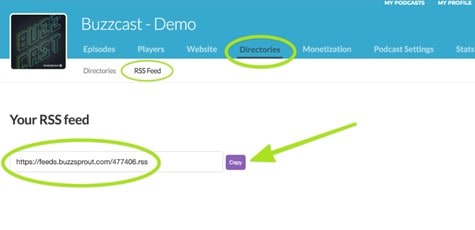
Step2 Click on the Feed button. You should see the podcast RSS feed. You can easily copy it from there.
Part 4. How To Create an RSS Feed for a Podcast?
However, there is also a case that if you use a self-hosted website for podcasting, you’ll require a plugin to generate your podcast RSS feeds. You can’t use it as it’ll include other blog content instead of the podcast, although your website might have its own RSS feed,
Then it’s high time to create a podcast RSS feed. Nevertheless, the process depends on whether you’re using a hosting service or not. Read on to find out how to create an RSS feed with or without a hosting platform;
Method 1: Create an RSS feed with hosting platforms
As mentioned, once you create an account with a podcast hosting website, your podcast RSS Feed will be automatically created. So you just need to complete your account setup, and once you publish a new podcast episode, you can find the RSS Feed in the relevant section of the podcast hosting platform.
We used the Castos hosting website to generate a podcast RSS Feed in the steps below;
Step1 Visit Castos website and set up an account with them.
Step2 Create a new podcast episode and fill in all necessary details in the relevant boxes.
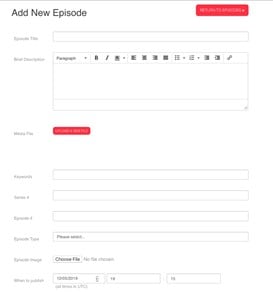
Step3 Navigate to the Podcast Setting area and provide your podcast information, such as Title, Description, Cover art, etc. Afterward, click the relevant button to proceed.
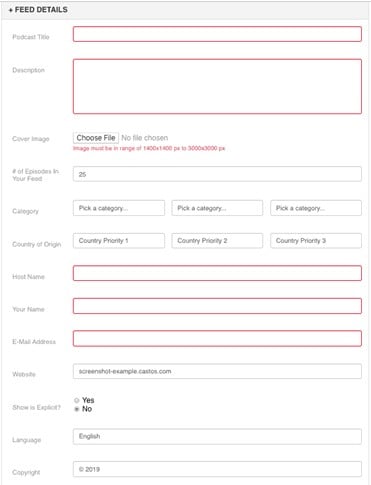
Step4 Once you successfully save your podcast details and upload the new episode, navigate to the Dashboard and locate your Podcast RSS Feed in the Distribution tab.

Method 2: Create an RSS feed without a hosting platform
Since the native RSS Feed of a self-hosted website usually contains blog article content, which is not needed in a podcast RSS Feed, you need a plugin like Powerpress to generate your podcast RSS feed.
The PowerPress plugin allows you to generate RSS feed containing only your podcast audio once you publish new content on your website. The following steps explain the process of creating an RSS feed without a hosting platform;
Step1 Open WordPress and log in to the backend of your WordPress website. Then, select Plugins from the left side and click Add New.
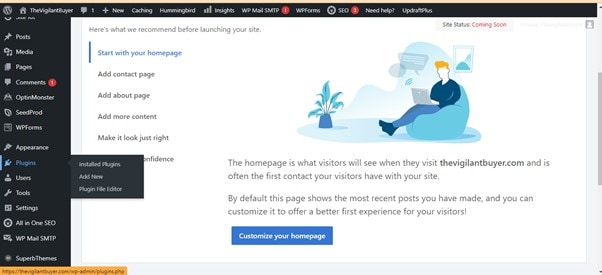
Step2 Search Powerpress plugin and click the Install button next to “PowerPress Podcasting Plugin by Bluburry. After the installation, activate the plugin.
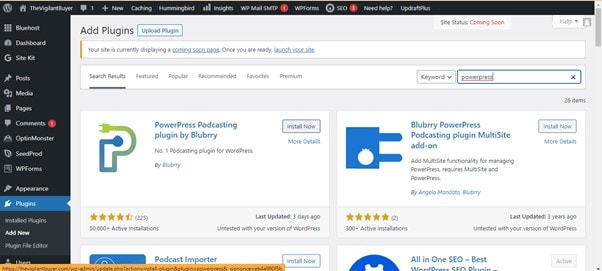
Step3 Once you install and activate the PowerPress plugin, it should appear at the bottom of the left sidebar. Click on it and select Settings.
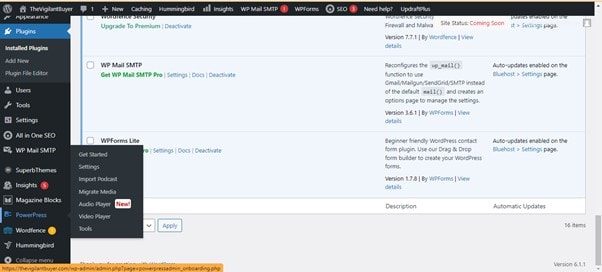
Step4 Click Feed, and you’ll see your RSS Feed link. Also, you can adjust settings for your podcast from this page. It’s as simple as that!
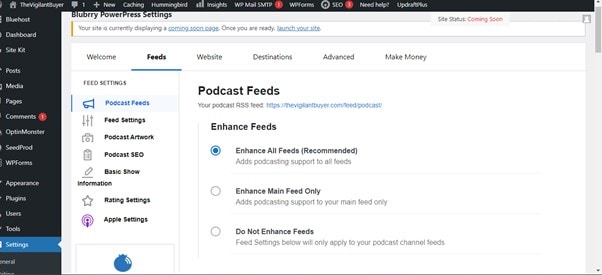
Method 3: Create your own exclusive RSS feed
You can also create your podcast RSS feed without a hosting platform or a self-hosted website. The RSS website can be accessed, and the process is pretty simple. See how this works below;
Step1 Visit RSS.com and sign up for an account for free.
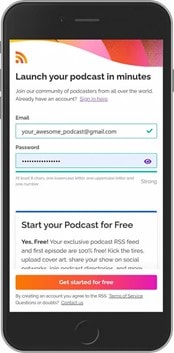
Step2 Confirm the email address you used to sign up for an account. Then, click New Podcast.

Step3 On the new page, enter the Title, Description, and RSS address feed address for your podcast.
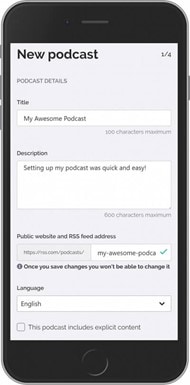
Step4 Add your author details, podcast categories, and podcast cover art on the new page. Then, click Save and Finish. Afterward, click the “RSS Feed” button and copy your podcast’s RSS feed to submit it on any platform you like.
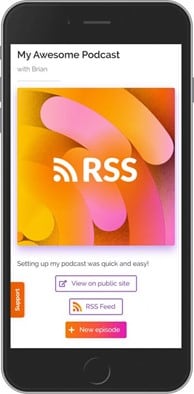
Having discussed all, you need to know how to create an RSS Feed for podcasts. Then, you can choose the best method to upload podcasts right now.
Part 5. Hot FAQs on Podcast RSS Feeds
Besides, we gathered some popular answers to some frequently asked questions from online users that you should know.
1. Does a podcast RSS feed cost?
You don’t need a dime to generate an RSS feed for your podcast. It’s 100% free!
2. Where can I distribute my podcast?
Various platforms you can distribute your podcast to include;
- Spotify
- Apple Podcast
- Google Podcast
- Bluburry
- Pobean
- Castbox
- Podchaser
- TuneIn, etc.
3. What is the difference between a podcast and an RSS?
A podcast is a video or audio show published on the internet, and it’s usually distributed to various podcasting platforms via RSS feed to make it available to subscribers. However, an RSS feed holds information about a podcast show and keeps subscribers up-to-date with every new podcast episode published.
Final Words
Creating a podcast RSS Feed is more straightforward than a ton would ever have imagined. At this point, we believe you’ve successfully set up a podcast RSS feed with a hosting platform, via a self-hosted website, or on your own. Regardless of your method to create the RSS few for your podcast, make sure you follow the steps correctly.
Nevertheless, if you’re looking for a reliable program to record and edit high-quality podcasts, we recommend using Filmora , as it offers the best tools to help you operate efficiently.
Free Download For Win 7 or later(64-bit)
Free Download For macOS 10.14 or later
Part 1. What Is an Podcast RSS Feed?
RSS, Really Simple Syndication, has been around for quite a long time (since 1999), and it was introduced to allow internet users to stay connected with their favorite websites. In other words, it’s used to subscribe to news websites, emails, blogs, podcasts, etc. It is just a simple link looking like this:

Your Podcast RSS feed makes the information about your podcast quickly accessible on various podcast directories, like Apple Podcast and Spotify. Yes, it holds the information about your podcast show and its episodes. So, whenever you create a new episode on the hosting website, it automatically updates it to podcast directories in real-time, thus making it accessible to listeners at their convenience.
Ultimately, an RSS feed saves you the stress of manually uploading new episodes of your podcast to various platforms! An RSS feed could also be referred to as;
- RSS channel
- Newsfeed
- RSS stream
- Web feed
Part 2. When to Use an RSS Feed
The concept of an RSS feed is pretty simple. It is what bridges the gap between your content and internet users. It means it’s not only helpful to podcasters but also to websites, blogs, etc.
As we all know, the average internet user won’t always have the time to visit your website or podcast channel to check new posts. So, by using RSS Feed on your website, podcast channel, email, etc., it’ll be easy for them to stay updated with every new content you publish.
RSS feed is necessary for any podcaster looking to thrive in the industry, and it’s the only way to allow your target audience to access your content quickly.
Part 3. How Do I Find the RSS Feed for My Podcast?
If you’ve uploaded podcasts to a hosting site and you’re wondering where to find the podcast RSS feed links, it’s pretty simple. You don’t need to do anything, as your RSS Feed will be automatically created once you set up your account on the platform.
Usually, the RSS feed can be found in Settings or the Directories tab. But, of course, that varies according to different hosting sites. So, we take buzzsprout as an example to show you how to get the RSS feed.
Step1 Open your podcast hosting website and navigate the Directories section. Then, locate any section tagged as Feed.

Step2 Click on the Feed button. You should see the podcast RSS feed. You can easily copy it from there.
Part 4. How To Create an RSS Feed for a Podcast?
However, there is also a case that if you use a self-hosted website for podcasting, you’ll require a plugin to generate your podcast RSS feeds. You can’t use it as it’ll include other blog content instead of the podcast, although your website might have its own RSS feed,
Then it’s high time to create a podcast RSS feed. Nevertheless, the process depends on whether you’re using a hosting service or not. Read on to find out how to create an RSS feed with or without a hosting platform;
Method 1: Create an RSS feed with hosting platforms
As mentioned, once you create an account with a podcast hosting website, your podcast RSS Feed will be automatically created. So you just need to complete your account setup, and once you publish a new podcast episode, you can find the RSS Feed in the relevant section of the podcast hosting platform.
We used the Castos hosting website to generate a podcast RSS Feed in the steps below;
Step1 Visit Castos website and set up an account with them.
Step2 Create a new podcast episode and fill in all necessary details in the relevant boxes.

Step3 Navigate to the Podcast Setting area and provide your podcast information, such as Title, Description, Cover art, etc. Afterward, click the relevant button to proceed.

Step4 Once you successfully save your podcast details and upload the new episode, navigate to the Dashboard and locate your Podcast RSS Feed in the Distribution tab.

Method 2: Create an RSS feed without a hosting platform
Since the native RSS Feed of a self-hosted website usually contains blog article content, which is not needed in a podcast RSS Feed, you need a plugin like Powerpress to generate your podcast RSS feed.
The PowerPress plugin allows you to generate RSS feed containing only your podcast audio once you publish new content on your website. The following steps explain the process of creating an RSS feed without a hosting platform;
Step1 Open WordPress and log in to the backend of your WordPress website. Then, select Plugins from the left side and click Add New.

Step2 Search Powerpress plugin and click the Install button next to “PowerPress Podcasting Plugin by Bluburry. After the installation, activate the plugin.

Step3 Once you install and activate the PowerPress plugin, it should appear at the bottom of the left sidebar. Click on it and select Settings.

Step4 Click Feed, and you’ll see your RSS Feed link. Also, you can adjust settings for your podcast from this page. It’s as simple as that!

Method 3: Create your own exclusive RSS feed
You can also create your podcast RSS feed without a hosting platform or a self-hosted website. The RSS website can be accessed, and the process is pretty simple. See how this works below;
Step1 Visit RSS.com and sign up for an account for free.

Step2 Confirm the email address you used to sign up for an account. Then, click New Podcast.

Step3 On the new page, enter the Title, Description, and RSS address feed address for your podcast.

Step4 Add your author details, podcast categories, and podcast cover art on the new page. Then, click Save and Finish. Afterward, click the “RSS Feed” button and copy your podcast’s RSS feed to submit it on any platform you like.

Having discussed all, you need to know how to create an RSS Feed for podcasts. Then, you can choose the best method to upload podcasts right now.
Part 5. Hot FAQs on Podcast RSS Feeds
Besides, we gathered some popular answers to some frequently asked questions from online users that you should know.
1. Does a podcast RSS feed cost?
You don’t need a dime to generate an RSS feed for your podcast. It’s 100% free!
2. Where can I distribute my podcast?
Various platforms you can distribute your podcast to include;
- Spotify
- Apple Podcast
- Google Podcast
- Bluburry
- Pobean
- Castbox
- Podchaser
- TuneIn, etc.
3. What is the difference between a podcast and an RSS?
A podcast is a video or audio show published on the internet, and it’s usually distributed to various podcasting platforms via RSS feed to make it available to subscribers. However, an RSS feed holds information about a podcast show and keeps subscribers up-to-date with every new podcast episode published.
Final Words
Creating a podcast RSS Feed is more straightforward than a ton would ever have imagined. At this point, we believe you’ve successfully set up a podcast RSS feed with a hosting platform, via a self-hosted website, or on your own. Regardless of your method to create the RSS few for your podcast, make sure you follow the steps correctly.
Nevertheless, if you’re looking for a reliable program to record and edit high-quality podcasts, we recommend using Filmora , as it offers the best tools to help you operate efficiently.
Free Download For Win 7 or later(64-bit)
Free Download For macOS 10.14 or later
Also read:
- [New] Accelerate Office Productivity with Speech Recognition (Word)
- [New] Gear Warriors Test Who Wins? GoPro Hero5 Black Vs. VIRB Ultra for 2024
- [New] Integrated Video Workflows on iOS
- [New] Synching Melodies to Photos Virtually
- [New] The Perfect Blend of Sound and Video Tips to Capture High-Quality Zoom Recordings for 2024
- [Updated] 2024 Approved Breaking News AFB's Secret to Trending Content
- [Updated] 2024 Approved Kinemaster's Guide to Fluid Film Segments
- [Updated] 2024 Approved Sierra Sovereign Dvd & Media Cutting Tools
- [Updated] Craft a Compelling Metaverse Presence with These Tools
- [Updated] In 2024, 10 Best Camcorder [Ultimate Review]
- [Updated] In 2024, Discovering the Most Admirable Podcast Microphones
- [Updated] Instagram Filters for the Win Maximize Likes & Comments Effortlessly for 2024
- 2024 Approved Unleash Creative Freedom Crafting Your Own Insta Tones
- Best 10 Collage Apps for Android (Top Picks)
- Enjoy Uninterrupted Excursions in Assassin's Creed: Valhalla for PC - Performance Issues Solved
- Harnessing ChatGPT's Capabilities for Tough Workplace Tasks
- New Best Reaction Video Editing Apps for iOS and Android Users
- Speedy Solution: Obtain Your Brother HL-3170CDW Drivers Today!
- Updated 2024 Approved Experience Seamless Video Editing on Windows 8 and Beyond
- Title: Initiatives to Enhance Your Podcast's RSS Feeds
- Author: Larry
- Created at : 2024-10-31 17:27:38
- Updated at : 2024-11-07 16:51:47
- Link: https://fox-glue.techidaily.com/initiatives-to-enhance-your-podcasts-rss-feeds/
- License: This work is licensed under CC BY-NC-SA 4.0.